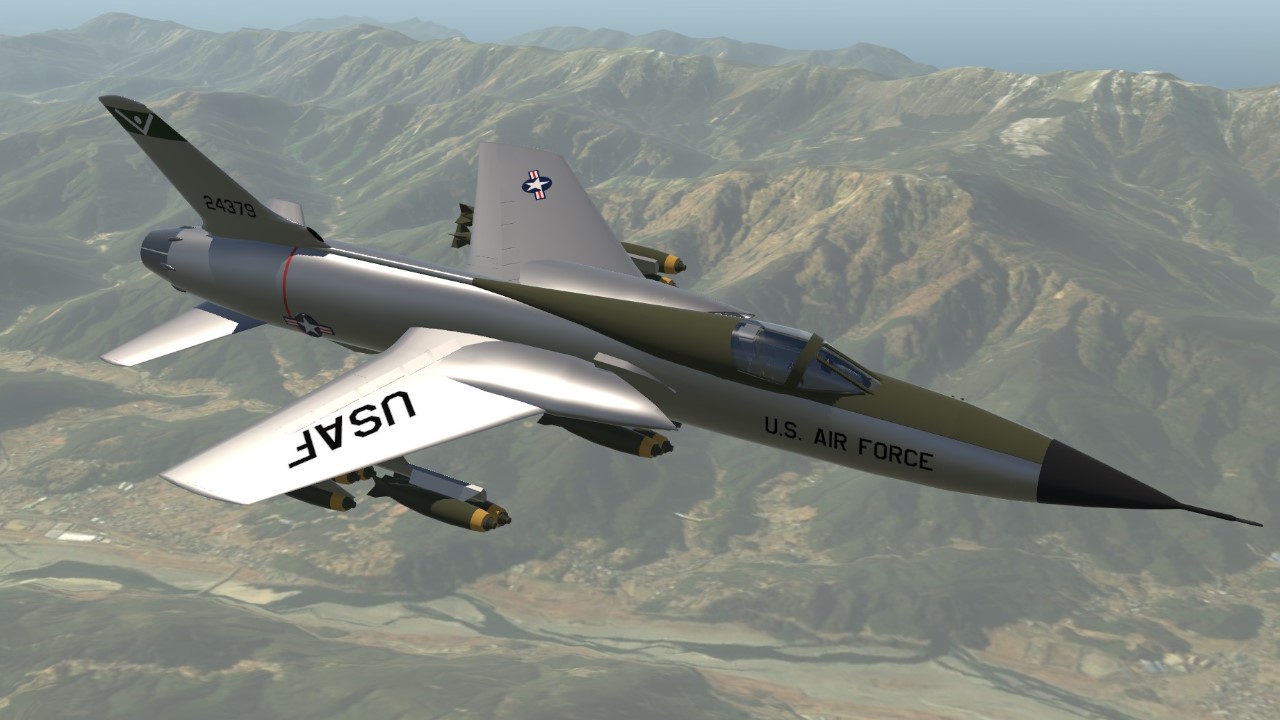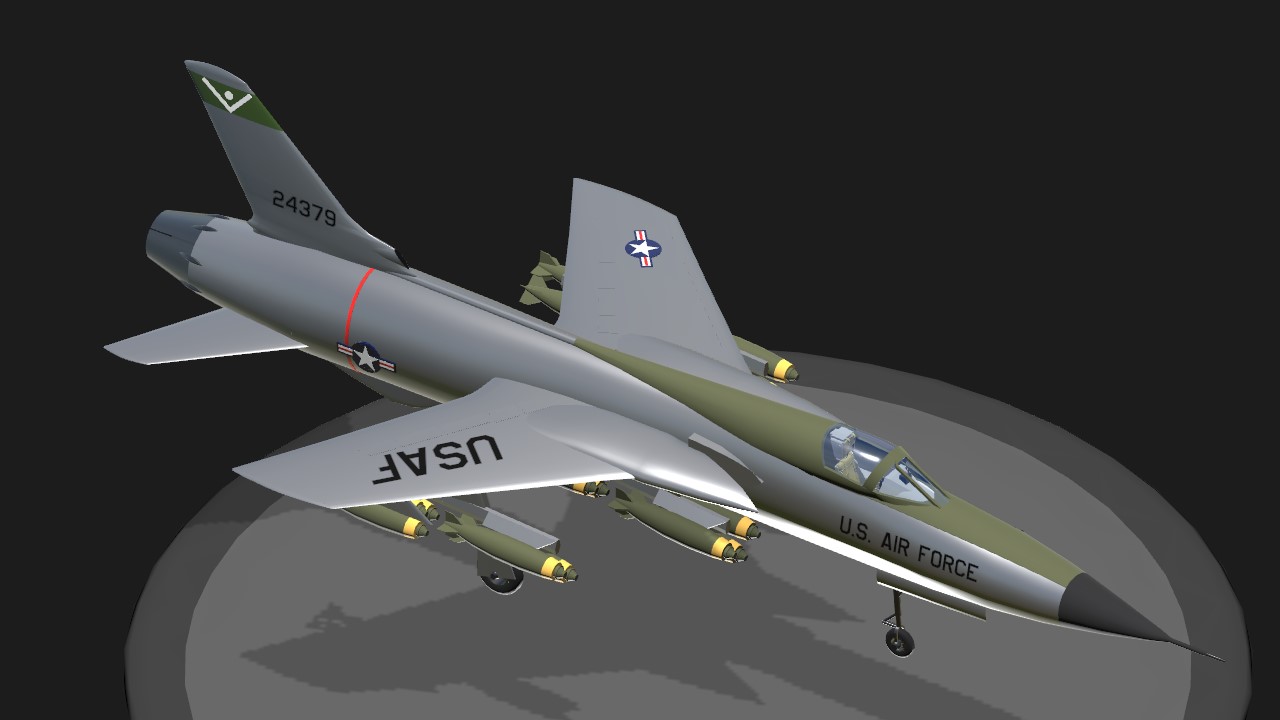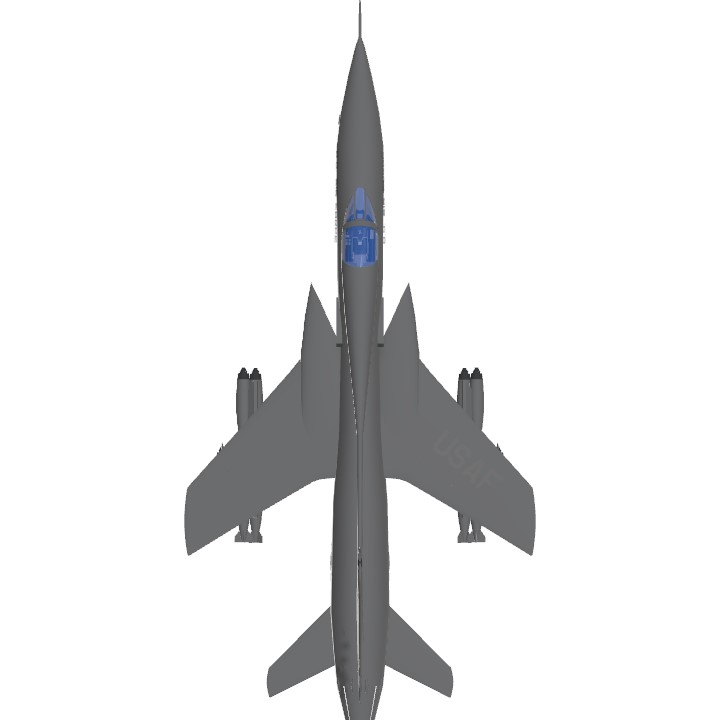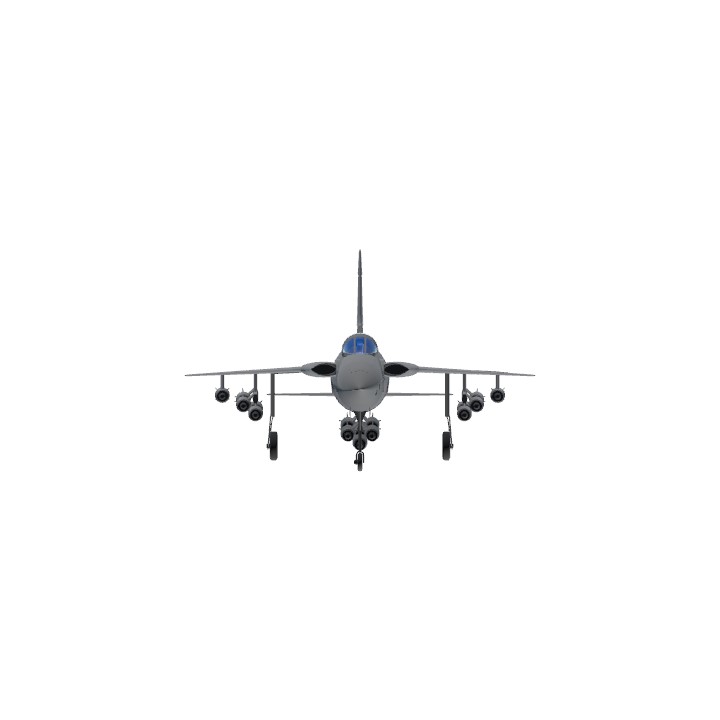The Republic F-105 Thunderchief was a supersonic fighter-bomber renowned for its large payload and fast speed, even at sea level.
Gallery:




Features:
- Armament: 1x 20 mm M61 Vulcan, 16x 750 lb M117
- Camouflage: USAF Bare Metal
- Animated spoilers, exhaust petals, and other details
- Fairly accurate performance
- A cockpit that should be VR compatible
Nonstandard Controls:
- AG 1 and Yaw: Nose Steering
- AG 2: Air Brake
- AG 3: Drogue Chute
- Throttle>95% for Afterburner
- VTOL for flaps
- Trim for trim
Notes:
- Thanks ChiChiWerx for the USAF roundels
- Hold down Fire Weapons to quickly drop all bombs. Otherwise, weight imbalance can be a problem.
- This should go without saying, but don’t release bombs at low altitude or when pitching down…
Background:
Republic’s F-105 Thunderchief originated as a follow-on to the F-84F Thunderstreak. The original mission intended for the aircraft was high-speed, low-level nuclear delivery deep into the Soviet Union. But the Air Force’s requirements changed a number of times, and the desired engine was not ready for use in the prototypes. Development was lengthy and the project was even briefly canceled before being revived. The Thunderchief finally entered service in 1958, though early variants were limited by their avionics. Development culminated in the F-105D variant, which was capable of all-weather and night operations and entered service in 1960. 610 of the D model would be built, making it the definitive F-105.
The F-105 took full advantage of recent advances in propulsion and aerodynamics. It had a visibly area-ruled fuselage that narrowed at the wings and was easily recognizable by its wing root air intakes. Its long-range mission necessitated a large design to carry enough fuel. In fact, the Thunderchief was the largest and heaviest single-engine fighter when it entered service. This was somewhat offset by its powerful J75 engine, outputting over 26,000 pounds of thrust in afterburner. Capable of Mach 2 speeds at high altitude, it was one of the fastest aircraft of its time. Its wings were fairly small for its size, resulting in an aircraft that was stable and fast, but fairly sluggish and with a long takeoff roll.
The Thunderchief would not see combat until 1964, when it began carrying out strike missions over Vietnam. The capabilities of the “Thud”, as it came to be known, were hard to ignore. Flying at supersonic speeds at treetop height with a greater payload than the B-17, it was the main USAF strike aircraft of Operation Rolling Thunder. Despite its role as a bomber, the Thud would become the first aircraft to score an aerial victory with the new Vulcan cannon. In all, F-105s would shoot down at least 27 enemy fighters over Vietnam. The Thunderchief also proved effective in the Suppression of Enemy Air Defenses (SEAD) role, with the two-seat F-105F originally meant for training finding use as the aircraft of choice for the Wild Weasels.
But the Thud’s missions weren’t easy, and losses were high. Nearly half of all F-105s built were destroyed, either in combat or in accidents. The Thunderchief had to face off against SAMs and MiGs when “going downtown”, as its pilots called missions to Hanoi. The aircraft’s hydraulic system was infamously fragile, and an unlucky hit could result in a total loss of control. Furthermore, the belly fuel tank proved especially vulnerable to ground fire. As newer aircraft like the F-4 and F-111 became available, the Thuderchief was gradually retired from service. Upgraded F-105G models for SEAD would remain in service for a time longer, before ultimately being replaced as well. The F-105 was never exported. None are flightworthy today, but a number remain on display in museums.
Specifications
Spotlights
- This craft is curated
- DeathStalker627 2.3 years ago
- ChiChiWerx 2.3 years ago
- Johnnyynf 2.3 years ago
- ShinyGemsBro 2.3 years ago
- LonelyAustrianUhlan 2.3 years ago
- Bryan5 2.3 years ago
- TheCommentaryGuy 2.3 years ago
- Dragoranos 2.3 years ago
- FatPilotOne 2.3 years ago
- AnomalyYeet 2.3 years ago
- ChihiroFujisaki 10 months ago
- HuskyDynamics01 2.3 years ago
- MrCOPTY 2.3 years ago
General Characteristics
- Successors 2 airplane(s)
- Created On Windows
- Wingspan 31.3ft (9.5m)
- Length 64.1ft (19.5m)
- Height 19.8ft (6.0m)
- Empty Weight 25,659lbs (11,638kg)
- Loaded Weight 36,058lbs (16,355kg)
Performance
- Power/Weight Ratio 0.732
- Wing Loading 92.6lbs/ft2 (452.0kg/m2)
- Wing Area 389.5ft2 (36.2m2)
- Drag Points 1360
Parts
- Number of Parts 419
- Control Surfaces 5
- Performance Cost 2,359







Beautiful build! Really amazing recreation of this plane! If you’re looking for a unique and quick build idea, the wild weasel version of this would be pretty awesome
Fast speed? Hell I stall out on rotation every time!
Edit: I read the desc, it explains it all
Holy cappuccino, I thought, for a moment, my in-progress Thud somehow got published. lol
Sorry for opening the comment like that. Nice Thud build, very much appreciate the realistic-leaning performance, and cockpit's nice and clean, too.
Kinda impressed that your main landing gear works well even on low-physics also, as I've been struggling to get mine work on low physics. (Seems I was looking at a wrong solution, increasing part mass and stuff)
I love your planes dude!! Ever thought of making 4th generation fighters tho? Like F/A-18s, F-16s?
When Mirage F1?
Chance Vought F-8 Crusader please next, btw awesome job